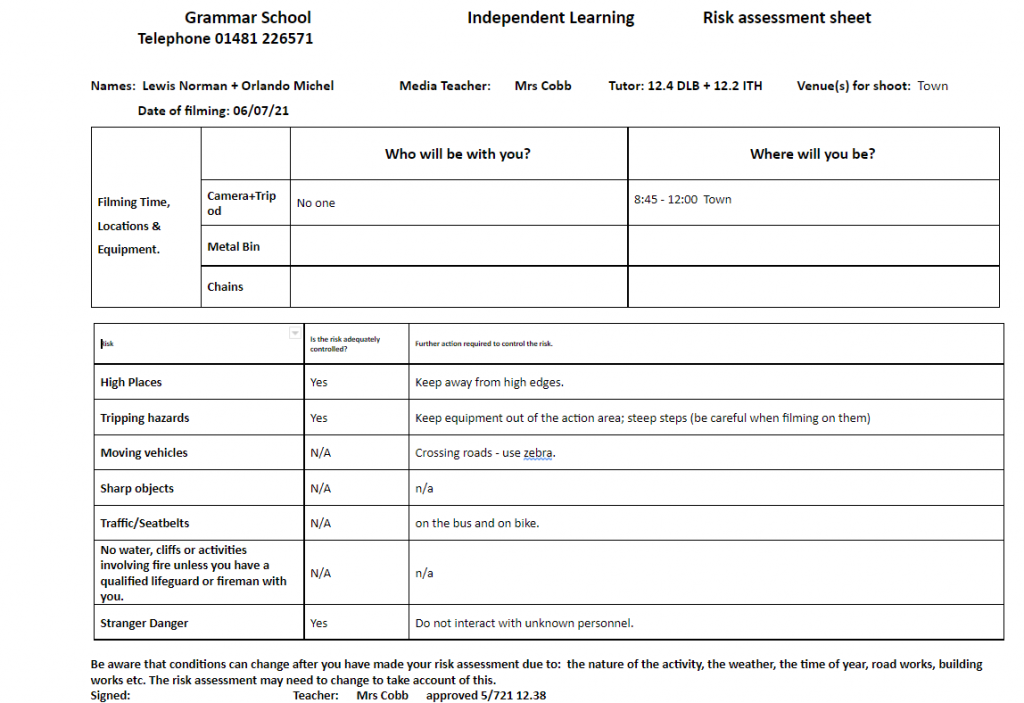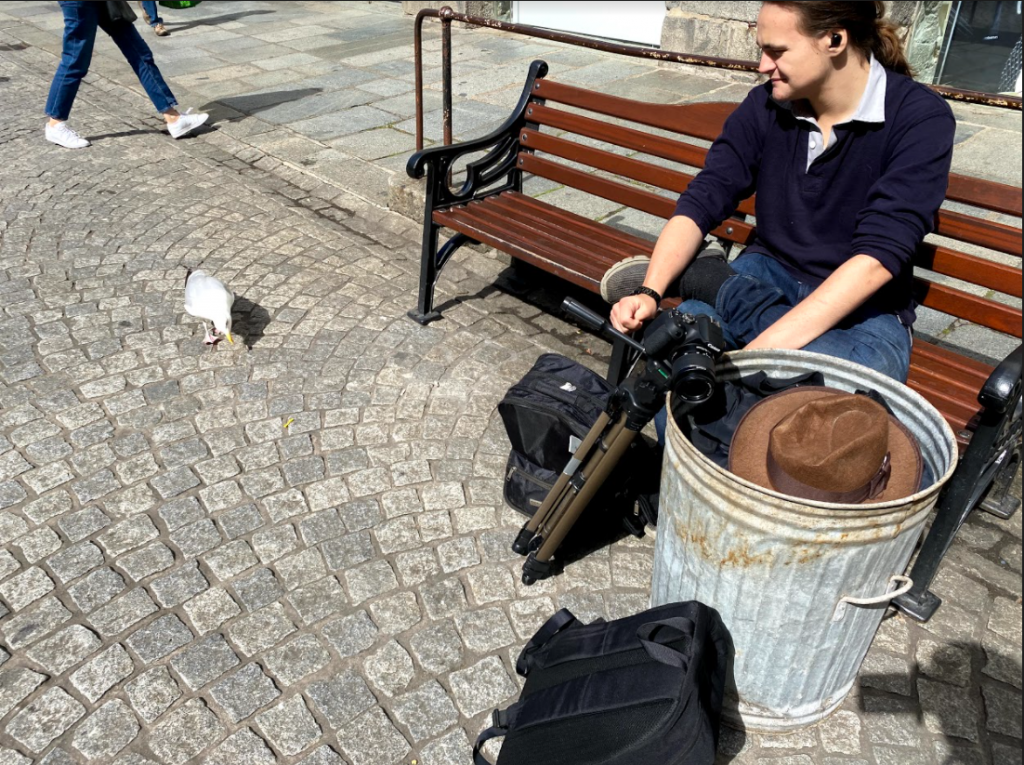Risk Assessment 2

This is our risk assessment; as we are in town, we will make sure to avoid these certain hazards, or maintain a level of control over them.
Evaluation of Narrative Shoot
For the Narrative shoot, me and my partner took a variety of shots all around Town, travelling all over in order to ensure we had enough footage. We filmed at the top of Smith Street, Market Square, up some stairs leading to Salvation Army, and looped around again.
It went well, with over 50+ clips of footage recorded, and double-takes in case of an issue being taken as well. We used varying camera angles and techniques, e.g ped/pan, which helped make the shoot less boring.
It was difficult to film in public areas without people looking at us (which went against the point of the lonely burden the bin bestowed upon the star), but we managed to push past and still get some good shots.
Reflecting on it, while the shoot went well with plenty of footage in differing locales, and with a good sum of usable footage (important), I feel as though we should have included more camera techniques, as well as different camera angles and shots (e.g POVs, extreme close-ups). I feel this as much of the footage includes “Dutch Angles” and mid-shots, which is fine in moderation, but not enough action was taken to make sure similar shots weren’t repeated.
These are a few photos taken during our shoot


(We should have taken more pick-up shots)
Shoot (Narrative) Reflection
Me and my team both shot our narrative in Town, where we got a variety of angles and locations into the mix. We also filmed in some grungy looking areas, which fits with the genre of the “Man Who Sold The World”. We took a few photos to represent our time spent filming.
Specifically, we went to the Top of Mill Street, shot in Paul’s Garden, then down to Market Square, and up the stairs towards Sausmarez road and passed Elizabeth College, looping around to Paul’s Garden. This did go well, with plenty different locations playing a pivotal role in conveying the narrative, and effectively being the foundations for us to work off. However, I do feel as though some more organisation in our set route would have worked well, or even a few hours spent scoping out town to discover new potential shoot locations, as we did really stick to one part of town.



Performance Rough Cut Reflection (Draft 1)
For the rough cut, we went with a rapid-cut, fast-paced edit approach, in order to add “action” and energy to the clip.
While our editing was fine, I feel as though some variation could be used; e.g. effects in the background, some more filters used, and other editing techniques.
The clip itself is alright- but feels mostly standard and plain.
I believe we should focus on:
- More variation in editing
- Use more clips of the actual lip-sync
- Try and stick to the fast style, and try not to focus too much on a particular “scene” (as seen half way through the video, with a pan around to the drummer- which tends to drag)
Narrative Development
This is the Narrative Development me and my group created.



This Production Meeting will outline the basics for our shoot; Locations, Costumes, the narrative and main themes. We have decided on a variety of locales, such as the Prison Lanes, Delancey Bunker, and Town. These will be the main locations for our shoot.
We want to end the video with the resolution of the burden; being passed around and around again. A sense of equilibrium could be gained from this resolution, as the main character has finally given it away- or given in (if looked at from that perspective). Really the video can be interpreted in a number of ways, which is the feeling we want to convey when we finally publish.
Evaluation of Performance Shoot
Me and my partner shot our performance on the school grounds, specifically by pipes in order to represent the genre of “grunge”/rock, and to add a certain aesthetic to the footage.
The shoot went well;
- we took a variety of shots during the performance, of both drummer and lead singer/bassist,
- used several camera techniques, e.g “pan”.
However, while the shoot itself went well,
- I feel as though some amount of variety in locale could have increased the “depth” of the video,
- perhaps some more variation in camera techniques,
- as well as extra work on continuity
- and ensuring inappropriate objects are not seen within the filming area.
These photos can give an idea on our shoot- shot in a grungy location, as well as our costuming.


Group Agreement + Meeting Agenda
Me and my group went over our strengths and weaknesses, as well as the things we need to make sure to keep in mind in both pre-production, shooting, and post-production


We decided on the days we chose as well as shooting in-school in the afternoon specifically due to convenience and mutual agreement on the matter of setting, and time availability.




This is our meeting agenda, outlining key items such as props, outfits, locations and dates et al.
Risk Assessement


The risk assessment will give us an outline and guideline to abide by, ensuring our safety and providing teachers with the knowledge of where and what we are filming with, as well as the hazards needing to be kept in mind
Star Image: The Performer

This Moodboard represents a bitesized depiction of the band “Nirvana”; the band who covered the “Man Who Sold The World”; the version of the song we used in our video.
Reflecting on this, we can say for sure that their success skyrocketed the grunge genre, as well as their unconventionality in the music scene. Their costuming isn’t over the top; it is ordinary, but the stars themselves are extraordinary in personality and song. Kurt Cobain’s voice, and the raw instrumental of the band, are both combined into a pure, guttural sound. Their appearance also reflects this, always looking “slackish” and apathetic. This presents them as a band who goes against convention, striking out of their own accord and willing to lead the charge. Kurt Cobain himself, often seen as the head of a generation, represents the apathy of his era, and is used as an icon to represent millions, and the genre of grunge.
This gives us an idea on what kind of “star” we want to present, what the star image should be constructed to seem. Combining the ordinary with extraordinary, I am confident we can put a “spin” on costuming and tone of the video.